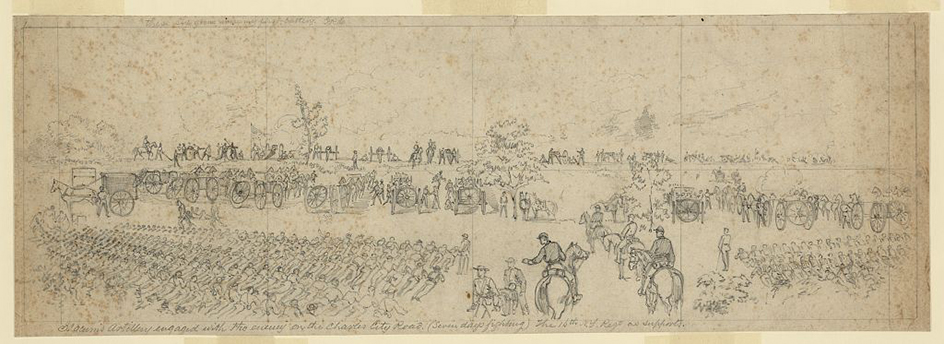Seven Days, Battles of the, were an important series of battles during the American Civil War (1861-1865). The battles were fought in southeastern Virginia from June 25 to July 1, 1862. Confederate forces led by General Robert E. Lee stopped Union General George B. McClellan’s drive for the Confederate capital at Richmond, Virginia.

Background.
In the spring of 1862, General McClellan sailed his Union army from Washington, D.C., to the peninsula between the York and James rivers in Virginia. The move marked the beginning of the war’s peninsular campaign. McClellan’s forces, which would grow to about 105,000 soldiers, headed for Richmond. McClellan’s advance was opposed by Confederate General Joseph E. Johnston and his 60,000 troops.
From May 4 through June 9, about 17,000 troops led by General Stonewall Jackson were positioned in the Shenandoah Valley. Jackson’s men prevented the Union from sending the reinforcements that McClellan was counting on.
On May 31 and June 1, Johnston attacked McClellan at the Battle of Fair Oaks (or Battle of Seven Pines) in Virginia. However, the Confederates failed to follow up on their initial success and were driven back toward Richmond. During the battle, Johnston was wounded and replaced with General Lee.
After the battle, Lee’s army was reinforced to about 85,000 men. However, due to faulty intelligence reports, McClellan believed that Lee had 200,000 soldiers against his 100,000. McClellan was therefore reluctant to resume the offensive and sent telegrams to Washington, D.C., requesting reinforcements and explaining why he could not attack. McClellan’s army at this time was divided into two groups. About 30,000 men led by Union General Fitz-John Porter were stationed north of the Chickahominy River, and about 70,000 men were south of the river.
While McClellan was waiting, Lee planned to attack. The Confederates built entrenchments (fortified positions) around Richmond so that part of Lee’s army could hold the city while the rest attacked McClellan’s troops. From June 12 through 15, Confederate General Jeb Stuart led a cavalry raid of about 1,200 men who circled McClellan’s army. This raid boosted Southern morale and provided Lee with valuable information about Union troop movements.
North of the Chickahominy River.
On June 25, the Battles of the Seven Days began with a small battle near Oak Grove, a few miles east of Richmond. The Union attacked the Confederates, but their advance stalled outside of Richmond.
On June 26, Lee attacked the Union at the Battle of Mechanicsville. Lee sent about 60,000 troops to attack Porter’s 30,000 troops, while the remaining 25,000 Confederates guarded Richmond. Even though Lee’s plan left McClellan with nearly three times as many troops south of the river as Lee had, McClellan overestimated Lee’s troop strength and did not attack.
Lee had planned for Stonewall Jackson’s troops to attack the Union flank (side) while the rest of the Confederate army attacked the Union entrenchments. However, Jackson was late arriving to the battlefield. When he finally arrived in the afternoon, instead of attacking the Union flank, he camped his men a few miles away from the battle. Historians do not know why he made camp instead of attacking. That afternoon, Confederate General A. P. Hill attacked the Union entrenchments with his part of Lee’s army. The attack failed, and the Confederates suffered about 1,400 casualties, compared to about 360 for the Union. Despite the victory, McClellan ordered Porter to fall back 4 miles (6.5 kilometers) to Gaines’s Mill.
On June 27, Lee attacked Porter’s troops at the Battle of Gaines’s Mill. But Jackson took the wrong road, and, again, his troops arrived late to the battlefield. After a series of uncoordinated attacks, the Confederates finally broke through the Union lines and forced Porter to retreat across the Chickahominy River. The Confederates had about 9,000 casualties and the Union about 6,800. Meanwhile, McClellan still overestimated the Confederate forces guarding Richmond and refused to attack Lee’s outnumbered troops.
South of the Chickahominy River.
After Gaines’s Mill, McClellan decided to withdraw the whole army south to a new base on the James River. Lee chased McClellan in an attempt to defeat the Union army before it could reach the river.
On June 29, the two sides met for a small battle at Savage Station. Lee sent troops under generals Stonewall Jackson and John Magruder to attack the troops who were protecting the retreating Union soldiers. For the third time in the campaign, Jackson was late, and Magruder’s assaults failed.
The next day, the two sides met near Glendale at the Battle of Frayser’s Farm. Lee planned to send all of his troops in an attack on the Union position. However, some Confederate troops were delayed cutting their way through a thick forest, and Jackson’s troops were delayed rebuilding a bridge. The remaining Confederate troops assaulted McClellan’s lines, suffering about twice as many casualties as the Union. That night, the Union troops withdrew 3 miles (5 kilometers) to Malvern Hill.
On July 1, the Confederates fought the Union at the Battle for Malvern Hill. At 1 p.m., the two sides began an artillery duel that lasted for several hours. Lee, thinking that the Union troops were withdrawing, and frustrated with his army’s previous inability to destroy McClellan’s troops, ordered a direct frontal attack. A series of ineffective assaults resulted in about twice as many casualties for the Confederates as for the Union. That night, McClellan retreated to his base on the James River. Lee decided that it would be unwise to attempt any more attacks.
Aftermath.
Over the course of the seven days of fighting, the Union suffered about 15,800 casualties, and the Confederates about 20,100. McClellan was ordered to withdraw his army from the peninsula and unite it with General John Pope’s troops, who were already in northern Virginia. In late August, Lee and Pope would meet at the Second Battle of Bull Run (or Second Battle of Manassas).
